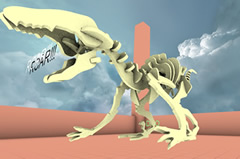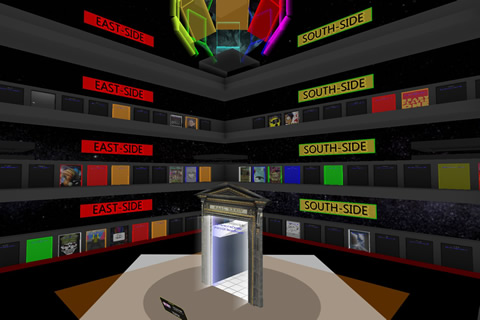We’re all used to exploring the Web with hyperlinks to get from place to place. But what if the Internet were more like a video game – a virtual mansion that you inhabit, entering rooms to get the content you’re looking for?
That’s the basic concept behind Janus VR, a software platform created by James McCrae (PhD 2014), a graduate of the computer science department’s Dynamic Graphics Project. Still under development, Janus VR renders the Internet as a virtual world. In the version he recently demonstrated, web links became doors, and web pages became rooms, where images and videos can hang on the walls, like art in a gallery.
McCrae says Janus VR can be used with a regular computer monitor, but he sees greater potential for the software in combination with a virtual reality headset, such as the Oculus Rift, which gives users the sense that the “screen” is all around them.
Why would you want a 3-D experience browsing the Net, when mostly you want to just click on a link to retrieve a file? Well, imagine the file contains something you want to see from all sides – such as a molecular or protein visualization, or an architectural rendering (which still have to be created using geometry modelling software). “Maybe you work in real estate and want to show a room to someone. You’d be able to virtually enter that space without having to physically go there,” says McCrae.
The program gives users a good sense of the scale of what they’re looking at. A virtual visit to the ROM’s dinosaur exhibit, for example, would allow users to truly grasp the skeletons’ immense size.  McCrae sees a broad range of educational uses for Janus VR. “You can picture this as a virtual field-trip or guided museum tour.”
McCrae sees a broad range of educational uses for Janus VR. “You can picture this as a virtual field-trip or guided museum tour.”
McCrae also sees potential for people to engage in spontaneous “virtual meetings” at web sites. “Imagine you and I find ourselves at an Amazon-like site at the same time because we’re both interested in a particular product. This happenstance meeting provides a context for us to strike up a conversation to discuss the product we are considering buying. The software provides the sense of meeting with someone in virtual space,” he says.
McCrae has started sharing his software with other developers, who, he says, appreciate its simplicity. “If you have a basic knowledge of HTML, it’s easy to rapidly create these ‘rooms.’” His next step: build a company, and, if things go well, raise some money to hire employees, which would enable him to add more features more quickly.
Down the road, who knows? “This is the tip of the iceberg,” he says. “I’m going to keep working on it.”







No Responses to “ Don’t Click That Link — Walk Through That Door! ”
I work in this and have seen some of the rooms already pass the quality and functionality of some of the "games" being developed for the Oculus Rift. It's moving at a very fast pace.